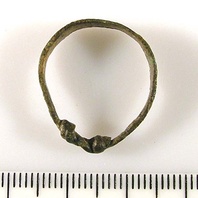
Viking Objects
Copper-Alloy Finger-Ring (LIN-E42F77)
The ring is formed by a flat band tapering to ends which have been knotted together. The outer face of the band is decorated with a row of punched ring and dot motifs.
Read More
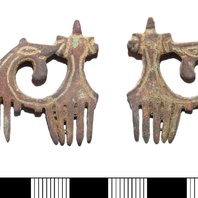
Viking Objects
Comb Pendant (LIN-DD07D2)
The pendant is decorated with two inturned zoomorphic heads executed in Ringerike-style ornament. These comb-shaped pendants are closely paralleled in the area around the Baltic Sea such as northwest Russia, Finland, Latvia and Lithuania, with rare examples from Estonia and Sweden. Pendants were a popular dress accessory in Norway and Sweden and sometimes were worn with beads between a pair of oval brooches. In England, pendants did not have the same popularity and there do not seem to be any contemporary Anglo-Saxon pendants.
Read More
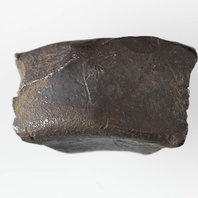
Viking Objects
Arm Ring Hacksilver (CM_1826_2001)
This piece of hacksilver was cut from a square section of a Scandinavian arm ring probably to pay for goods. The Vikings arriving in England had a bullion economy where they paid for goods with silver that was weighed to an amount agreed between the buyer and the seller. Hacksilver and silver ingots are the most common evidence for their bullion economy. It took some time for the Scandinavian settlers to adopt a monetary economy like that of the Anglo-Saxons, and both systems were used simultaneously for a while before they fully adopted the new system. They were familiar with monetary economies but they treated coins as just another form of silver before adoption of a monetary economy.
Read More
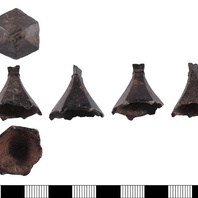
Viking Objects
Norse Bell (LIN-4509A8)
Bells of this type are described as a ‘Norse’ bell because of their association with Scandinavian sites though not much else is known about their purpose or origin. However, it seems likely that they were used as harness decorations.
Read More
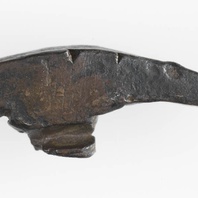
Viking Objects
Silver Thor’s Hammer Pendant (CM_1841_2008)
This is a high quality hammer-head section of a silver Thor’s hammer pendant. These may have been worn to show devotion to the god Thor, or to secure the god’s protection, although there is little evidence to support this interpretation. Pendants like this have been found made of lead, copper alloy, silver and gold, showing that many different strata of society could have worn them. For more information on Scandinavian jewellery in England check out our blog: Brooches, Pendants and Pins: Scandinavian Dress Accessories in England.
Read More
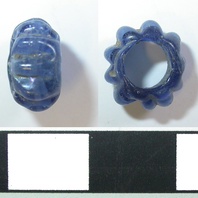
Viking Objects
Blue Glass Bead (2001/59-sf174)
This Viking Age gadrooned or Melon type dark blue glass bead was found in the Magistrates Court excavation in Derby, Derbyshire. Glass beads were a coveted item for making jewellery with some being imported from as far away as the Middle East. They were manufactured by specialised artisans who would heat various coloured glass rods over a furnace and melt the glass onto a metal stick to form different shaped beads.
Read More
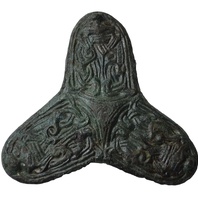
Viking Objects
Trefoil brooch (LCNCC : 2011.99)
A trefoil brooch with Borre/Jellinge-style cast ornament belonging to Peterson’s type 109. The brooch is most probably cast of copper alloy with traces of gilding on its upper surface and white metal plating on the reverse. While of Scandinavian design, many examples found in the East Midlands were probably made in the Danelaw, and may have been copies of Scandinavian styles, instead of being imported from Scandinavia. For more information on Scandinavian jewellery in England check out our blog: Brooches, Pendants and Pins: Scandinavian Dress Accessories in England.
Read More
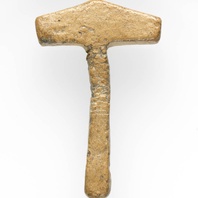
Viking Objects
Lead Thor’s Hammer Pendant (CM_569_2010)
A lead Thor’s hammer pendant with a trapezoidal head and pierced base. These may have been worn to show devotion to the god Thor, or to secure the god’s protection, although there is little evidence to support this interpretation. Pendants like this have been found made of lead, copper alloy, silver and gold, showing that many different strata of society could have worn them. For more information on Scandinavian jewellery in England check out our blog: Brooches, Pendants and Pins: Scandinavian Dress Accessories in England.
Read More
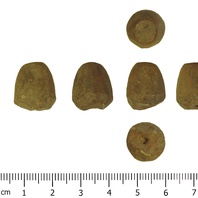
Viking Objects
Lead-Alloy Gaming Piece (DENO-7DABAC)
Lead gaming pieces like this one are a common find throughout the East Midlands, including the Torksey Viking camp. Gaming pieces would have been used to play games such as hnefatafl or Nine Men’s Morris, both of which are known to have been played by Scandinavians throughout the Viking diaspora.
Read More
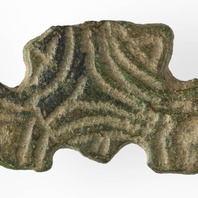
Viking Objects
Trefoil Brooch Fragment (CM.1823_2008)
A fragment of a Scandinavian copper-alloy trefoil brooch with a simple line pattern following its general outline. While of Scandinavian design, many examples found in the East Midlands were probably made in the Danelaw, and may have been copies of Scandinavian styles, instead of being imported from Scandinavia. For more information on Scandinavian jewellery in England check out our blog: Brooches, Pendants and Pins: Scandinavian Dress Accessories in England.
